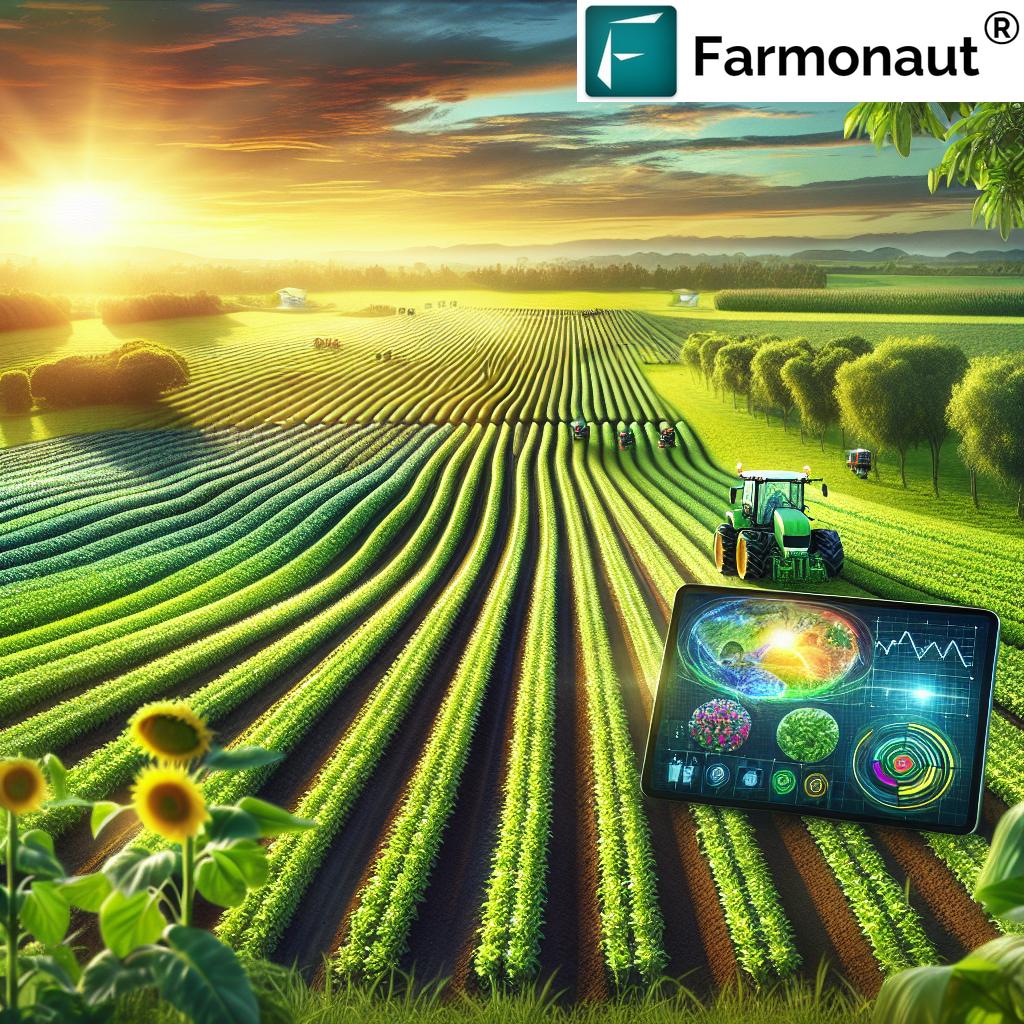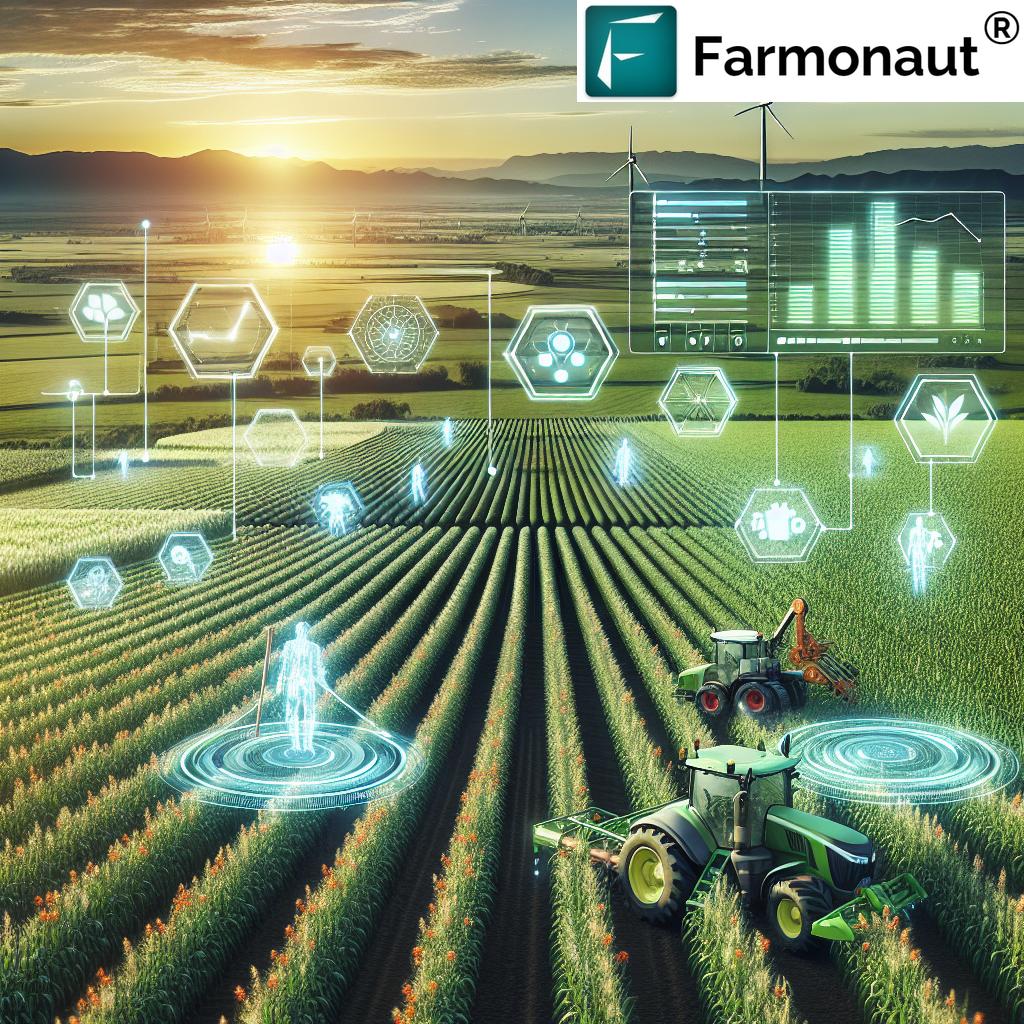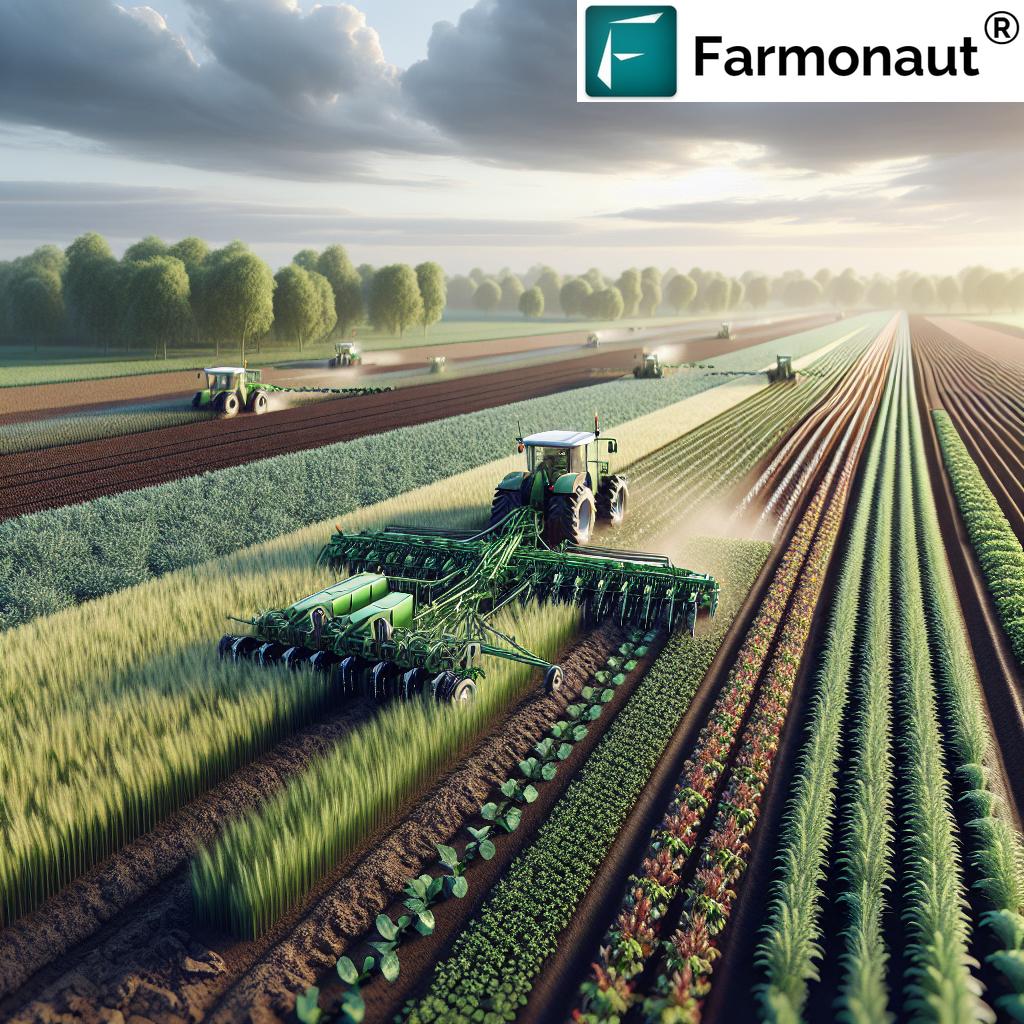Above-Ground Pests Corn & Biomass: Irrigation System 2025 | Boost Yields with Precision Farming
“Over 30% of corn yield losses are caused by above-ground pests annually, highlighting the need for advanced pest management.”
Table of Contents
- Introduction: The Paramount Need for Advanced Corn Management in 2025
- Above-Ground Pests in Corn Cultivation
- Integrated Pest Management (IPM) Techniques for 2025
- Remote Sensing & Biological Advances: Pest Monitoring in Precision Farming
- Above-Ground Irrigation Systems: Efficient Water Use and Technology Integration
- Smart Irrigation in 2025: The Role of IoT and AI in Sustainable Water Management
- Above-Ground Biomass Estimation: Precision, Data, and Carbon Impact
- Comparative Overview Table: Pests, Biomass, & Irrigation Technology in Corn
- Integrative Perspective: Optimizing Yield, Productivity, and Environmental Impact
- How Farmonaut Empowers Sustainable Cropping with Satellite Solutions
- FAQs: Above-Ground Pests, Biomass, and Irrigation in Corn
Introduction: The Paramount Need for Advanced Corn Management in 2025
In modern agriculture, the integration of advanced techniques is paramount for efficient, sustainable crop management. Corn (Zea mays), one of the world’s most critical staple crops, faces constant challenges from above-ground pests, water stress, and the need for precise biomass estimation. As 2025 approaches, farmers worldwide are increasingly relying on technology-powered solutions like remote sensing, AI algorithms, and IoT-driven irrigation systems, supported by companies like Farmonaut, to optimize yield, resource use, and minimize environmental impact.
This comprehensive guide explores the interplay of above-ground pests corn, above ground irrigation systems, and above ground biomass estimation. These elements form the backbone of precision farming approaches that are influencing the future of corn cultivation across diverse geographies.
Above-Ground Pests in Corn Cultivation
Above-ground pests corn present a major challenge to farmers worldwide, directly influencing productivity and yield. Key insect threats include:
- Borers (e.g., European Corn Borer): Damage stems, disrupt photosynthetic capability, and expose crops to disease.
- Armyworms: Defoliate plants, reducing foliage area critical for biomass accumulation.
- Aphids: Extract sap from stems and leaves, often spreading viral diseases.
- Leafhoppers: Feed on plant juices, directly weakening plants and indirectly introducing pathogenic microorganisms.
These pests attack the above-ground parts of the plant— leaves, stems, and ears. They threaten overall crop capability to synthesize energy, resulting in direct yield reductions and significant biomass loss. Effective management strategies are no longer a luxury; they’re an absolute necessity for sustainable agriculture in 2025 and beyond.
Factors Influencing Above-Ground Pest Corn Proliferation and Impact
- Climate variability: Warmer temperatures and erratic rainfall in 2025 encourage rapid pest life cycles and population booms.
- Intensive farming: Monocultural practices provide an uninterrupted food source for major pests.
- Pesticide resistance: Conventional pesticide use has led to evolved resistance, requiring integrated approaches.
Let us continue to examine how advanced techniques in 2025 are addressing this challenge for corn farmers worldwide.
Integrated Pest Management (IPM) Techniques for 2025
Integrated Pest Management (IPM) is at the core of contemporary pest control for corn cultivation. This strategy combines biological controls, beneficial insect release, and targeted chemical applications with near real-time monitoring to optimize yield while minimizing environmental harm. Advanced technologies help farmers to detect infestations early, identify stress signatures on corn foliage, and guide localized interventions.
- Biological controls: Releasing beneficial insects (e.g., parasitoid wasps, lady beetles) that prey on pest populations.
- Genetic advancements: Development of pest-resistant corn varieties that are less susceptible to above-ground pest attack.
- Targeted chemical applications: Applying pesticides (guided by real-time data) only where and when necessary, minimizing chemical use and risk to non-target organisms.
- Continuous monitoring: Using remote sensing technologies—including drones equipped with multispectral cameras—for precise identification and mapping of pest hotspots.
Benefits of IPM in Corn Farming
- Reduces unnecessary pesticide applications, which lessens possible resistance and reduces costs.
- Encourages beneficial insect populations and sustainable ecosystem balance.
- Enhances precision in pest management by targeting treatments only where needed.
2025 Outlook: AI & Data-Driven Pest Strategy
With the proliferation of big data, AI, and cloud-based advisory tools (like those from Farmonaut), the IPM strategy is becoming increasingly data-driven and proactive. Drones equipped with multi- and hyperspectral cameras can scan large farm fields in minutes, returning instant vegetation and stress maps for early detection of pest threats, allowing farmers to localize chemical or biological interventions for maximum efficiency and minimal impact.
Remote Sensing & Biological Advances: Pest Monitoring in Precision Farming
Modern pest management hinges on remote sensing technologies and biological advancements that empower farmers in making timely, informed decisions.
Remote Sensing: Immediate Stress Identification
- Multispectral cameras on drones or satellites can detect stress signatures (e.g., changes in NDVI, PRI indices) indicative of pest damage long before symptoms are visible to the human eye.
- Hotspot mapping enables farmers to allocate resources—both human and chemical—where they are needed most, minimizing environmental harm and maximizing impact.
Farmonaut leverages a blend of satellite imagery and AI for real-time crop monitoring and automated pest detection through indices such as NDVI, offering valuable insights that enable farmers to manage their crops precisely and sustainably.
Learn more about Farmonaut’s carbon footprinting services, designed to help agricultural operations monitor and reduce their overall environmental impact, a key component of sustainable pest management in the 2025 landscape.
Genetic and Biotechnological Innovations
- Pest-resistant hybrids: Genetic advancements have introduced corn varieties with inherent resistance to common above-ground pests.
- Biopesticide development: Use of targeted biopesticides, including those derived from plant peptides or microbes, offers eco-friendly alternatives that maintain crop productivity and minimize non-target impacts.
Summary Table: Key Above-Ground Pests and Their Agricultural Impact
| Pest Name | Infestation Rate (%) | Biomass Impact (kg/acre) | Suitable Irrigation Tech | Recommended Mitigation |
|---|---|---|---|---|
| Corn Earworm | 18–30 | –350 | Sprinkler & Smart Sensors | Biopesticide, Pheromone Traps |
| Armyworm | 10–22 | –275 | Drip, IoT Moisture Sensing | Biological Control, Spot Spraying |
| Aphids | 14–20 | –200 | Smart Sprinkler, Drip | Natural Predators, Neem Extracts |
| Leafhoppers | 8–17 | –165 | Sensor-based Pivot | SAT. Surveillance, IPM |
Above-Ground Irrigation Systems: Efficient Water Use and Technology Integration
Water management remains a central concern in corn farming, especially as climate variability intensifies in 2025. Above-ground irrigation systems—such as center pivots, linear move sprinklers, and sensor-controlled drip lines—provide efficient, flexible water delivery that is precisely tailored to crop demand.
Advantages of Above-Ground Irrigation Systems
- Rapid deployment and scalability: Easy to install, expand, and maintain for varying farm sizes.
- Direct control: Allows for easy modifications in irrigation volumes and timing, which is critical for optimizing biomass and minimizing nutrient leaching.
- Integration with IoT devices: Enables real-time soil moisture monitoring and smart irrigation scheduling.
- Disease management: Proper scheduling can prevent over-moist foliage and reduce fungal outbreaks.
Types of Above-Ground Irrigation Technologies
- Center pivots: Ideal for large, round fields in regions like Mazimba, Malawi, and the US Midwest.
- Linear move sprinklers: Well-suited for rectangular/large-scale commercial plots, providing even water distribution.
- Sensor-based drip: Use moisture sensors and IoT scheduling to minimize water use while maintaining optimal biomass output.
“Precision irrigation systems can reduce water usage in corn fields by up to 40% while maintaining optimal biomass growth.”
Smart Irrigation in 2025: The Role of IoT and AI in Sustainable Water Management
The rise of smart irrigation systems in 2025 is revolutionizing water use efficiency for corn farming worldwide. Armed with AI algorithms that analyze weather forecasts, soil moisture data, and growth stages, these systems enable data-driven scheduling—delivering exactly the right amount of water, only when and where it’s needed.
Key Elements of Smart Irrigation Systems
- IoT moisture sensors: Continuously monitor soil conditions, feeding data to cloud-based management platforms.
- Weather-integrated scheduling: AI-powered systems adjust irrigation schedules automatically based on precipitation forecasts and evapotranspiration rates.
- Remote access: Mobile and web apps allow farmers to control and monitor irrigation from anywhere.
Farmonaut’s technology is designed to integrate satellite-driven insights with local field sensors, giving users a complete resource management toolkit. Explore Farmonaut’s Large Scale Farm Management solution—optimal for enterprises and cooperatives seeking to scale efficiency in water, pest, and biomass management.
Impact on Yield and Sustainability
- Reduced resource use: Precision irrigation can save up to 40% water, while boosting plant health and maximizing biomass yield.
- Minimized disease risk: Lessening excess leaf-wetting reduces foliar diseases.
- Facilitates sustainable expansion: Smart systems adapt easily to different plot sizes and geographies.
Mobile-Responsive Solutions for Modern Farmers
 |
 |
 |
Read about Farmonaut’s Fleet Management Tools for agricultural logistics and equipment tracking, crucial for ensuring that irrigation and pest monitoring interventions are conducted efficiently across vast fields.
Above-Ground Biomass Estimation: Precision, Data, and Carbon Impact
Above ground biomass estimation is a critical aspect of modern, sustainable corn agriculture. Ensuring optimal biomass production is directly tied to yield, carbon sequestration, and long-term soil health.
The Evolution of Biomass Estimation Techniques
- Traditional destructive sampling: Time-consuming, labor-intensive, and impractical for large-scale operations.
- Remote sensing: Using satellite and drone imagery combined with machine learning models for rapid, large-scale, non-invasive biomass assessment.
- Vegetation indices: Tools like NDVI interpret canopy structure and spectral reflectance for accurate, real-time insights.
The use of advanced algorithms and data integration (as provided by Farmonaut) ensures farmers have access to actionable biomass data—enabling them to fine-tune fertilizer applications, plan for harvest, and effectively manage crop residues to promote sustainable soil fertility.
Key Benefits of Accurate Biomass Estimation
- Yield prediction: Early season biomass assessments help forecast total yield potential.
- Nutrient management: Data-driven insight assures more efficient use of fertilizer, reducing runoff and environmental impacts.
- Carbon budgeting: Quantifying biomass aids in tracking carbon sequestration for meeting climate goals.
- Crop insurance and traceability: Reliable estimates are essential for quick, accurate insurance claims and transparent supply chains; see Farmonaut’s crop loan and insurance solutions.
Farmonaut for Biomass Estimation & Environmental Impact Monitoring
Through a combination of satellite-based monitoring, AI, and blockchain, we at Farmonaut provide API integration and real-time satellite insights, ensuring farmers and stakeholders have regular, accurate updates on crop health and biomass.
Learn more about our public API and explore our Developer Docs for building custom applications on satellite, weather, and crop data.
For businesses requiring traceability across supply chains, our blockchain-based product traceability solution ensures transparency and security, further fostering trust with end consumers and partners.
Comparative Overview Table: Pests, Biomass, & Irrigation Technology in Corn
| Above-Ground Pest | Estimated Infestation Rate (%) | Estimated Biomass Loss (kg/acre) | Recommended Irrigation Technologies | Suggested Mitigation Strategies |
|---|---|---|---|---|
| Corn Earworm | 18–30 | Up to –350 | Sprinkler, Smart Sensors, IoT Drip | Biopesticide, Pheromone Traps, Timed Irrigation |
| Armyworm | 10–22 | Up to –275 | Drip, Moisture Sensors, Smart-Connected Pivots | Biological Control, Variable Rate Application |
| Aphids | 14–20 | Up to –200 | Smart Sprinkler, Drip, IoT Integrated | Natural Predators, Neem Biopesticides, Early Detection |
| Leafhoppers | 8–17 | Up to –165 | Pivot with Smart Sensors | Satellite Monitoring, IPM, Sanitation Practices |
Integrative Perspective: Optimizing Yield, Productivity, and Environmental Impact
Managing above-ground pests, optimizing water through smart irrigation, and leveraging advanced above-ground biomass estimation form a triad that is fundamental to precision farming in 2025. Each element enhances the effect of the others:
- Pest control preserves the photosynthetic capacity of corn, preventing significant biomass and yield loss.
- Smart irrigation supports resilient plant growth, regulates soil moisture, and prevents nutrient leaching or waterlogging that can compound pest and disease challenges.
- Accurate biomass estimation provides a foundation for adaptive nutrient management, harvest timing, and sustainable residue management—all while contributing important data for carbon accounting and environmental stewardship initiatives.
This integrative approach enables farmers and agribusinesses to manage resources efficiently and sustainably, building a resilient food supply and reducing per-acre emissions.
How Farmonaut Empowers Sustainable Cropping with Satellite Solutions
We at Farmonaut are committed to advancing technological innovation in agriculture. Our platform integrates satellite imagery, AI, and machine learning to deliver accessible, actionable insights for farmers, businesses, and governments worldwide.
- Satellite-based monitoring: Assess vegetation health, soil moisture, and irrigation needs, promoting timely interventions and labor savings.
- Jeevn AI advisory: Get weather, crop strategy, and pest/disease alerts tailored to field conditions.
- Blockchain traceability: Ensure transparent sourcing and supply chain verification, helping agribusinesses meet regulatory and consumer expectations.
- Environmental impact monitoring: Quantify carbon footprint and other environmental metrics for continuous improvement and sustainability certification.
Our solutions are available via web, Android, and iOS apps, as well as easy-to-integrate APIs, enabling maximum flexibility and accessibility for users of all scales. For actionable support in forest, plantation, and crop advisory, visit our dedicated advisory platform.
FAQs: Above-Ground Pests, Biomass, and Irrigation in Corn
1. What are the main above-ground pests affecting corn in 2025?
The major above-ground pests for corn include corn earworms, armyworms, aphids, and leafhoppers. These pests damage leaves, stems, and ears, leading to significant reductions in photosynthetic efficiency, biomass, and yield.
2. How do above-ground irrigation systems differ from subsurface systems?
Above-ground irrigation systems like center pivots, linear-move sprinklers, and sensor-driven drip lines deliver water at the soil surface or above, allowing for faster installation, easier maintenance, and integration with smart sensors for data-driven scheduling. Subsurface irrigation, in contrast, provides water directly to plant roots but can be more expensive to maintain and less flexible in varied topographies.
3. What is the role of remote sensing in modern corn biomass estimation?
Remote sensing uses satellite or drone imagery combined with vegetation indices (like NDVI) and machine learning algorithms to provide accurate, rapid, and non-destructive biomass estimation. This is crucial for yield prediction, fertilizer management, carbon accounting, and sustainability monitoring.
4. Can smart irrigation and data-driven pest management really boost yield?
Yes. Precision irrigation and data-driven IPM strategies conserve resources, optimize plant health, and minimize losses—together leading to significantly higher, more consistent yields and improved biomass output.
5. How does Farmonaut help manage the interplay of pests, irrigation, and biomass?
We at Farmonaut deliver satellite and AI-powered tools for monitoring, prediction, traceability, and advisory, supporting real-time decision-making for crop management on any scale.
6. How can farmers get started with Farmonaut?
Farmers and businesses can access Farmonaut’s services via web, Android, and iOS app buttons above. Developers and large enterprises can use APIs to integrate real-time insights directly into their platforms.
7. Why is above ground biomass estimation essential for carbon footprinting?
Accurate biomass estimation enables organizations to quantify how much carbon is sequestered by their crops—vital for sustainability initiatives, climate-smart certifications, and compliance with global climate action goals.
8. What other resources does Farmonaut offer for sustainable crop management?
We offer solutions for crop traceability, fleet management, loan and insurance verification, and comprehensive environmental monitoring that help streamline operations while supporting environmental stewardship.
For further reading or questions, visit our official website or download our mobile applications.
Conclusion: The Future of Above-Ground Pest, Biomass, and Irrigation Management in Corn
In the evolving landscape of 2025 agriculture, precision technologies and data-centric approaches are transforming corn cultivation worldwide. Above-ground pests, water management with above-ground irrigation systems, and data-driven biomass estimation form the foundation for sustainable, productive farming systems. By integrating remote monitoring, AI analytics, and responsive field interventions, farmers can now safeguard their yields, enhance resource efficiency, and advance toward climate goals with confidence. The synergy of these elements—empowered by digital innovation and satellite technologies from companies like Farmonaut—will be indispensable for the world’s food future.











